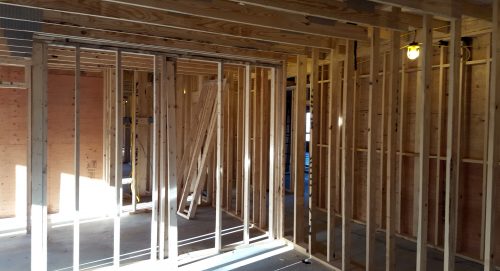Expert Tips
Live Load Reduction on Wood-Frame Bearing Walls
ASCE 7-10 requirements for calculating reduced uniform live load–e.g., to address high cumulative axial loads on the lower levels of multi-story buildings, and associated impacts on bearing wall stud layout.

ASCE 7-10, Section 4.7 permits reduction of live loads on certain structural members that have influence areas of at least 400 sf. ASCE 7-10 defines influence area as KLLAT where KLL is a live load element factor given in Table 4-2 and AT is the member’s tributary area. Studies have shown that, as a member’s influence area increases, the likelihood that the member will experience the full design live load over its entire tributary area decreases. Due to this, ASCE 7-10 equation 4.7-1 can be used to calculate a reduced uniform live load. This reduced live load is not permitted to be less than 50% of the unreduced live load from a single floor, or not less than 40% of the unreduced live load from multiple floors.
When applied to repetitive framing walls, the prevailing consensus in the engineering community is that live load reduction is intended for an individual element—e.g., a header or single stud—and not for the total load on the bearing wall system (for an example, see this article). Few individual members in wood-frame bearing walls will have an influence of at least 400 sf, indicating that live load reduction would not apply. However, should the minimum influence area for an individual element within the wall be reached, a reduction may apply. Rationally, many would consider it excessive to assume that the bearing wall studs on the lowest level of a 4- or 5-story wood-frame building would see 100% of the design live load from all supported levels simultaneously. However, ASCE 7-10 only permits a reduction of design live loads if the 400 sf influence area is reached.
One of the common reasons this question is raised is to deal with high cumulative axial loads on the lower levels of multi-story buildings, and the effects that these high loads have on bearing wall stud layout. The size and spacing of wall studs under these conditions is usually governed by the perpendicular to grain capacity of the wall plates. Below are several options for addressing this condition.
- Some wood species and grades have higher perpendicular to grain capacities than others. For example, common lumber for wall plates have Fc perp values ranging from 425 psi to 625 psi. Utilizing a species on the higher end of this range can accommodate almost 50% more load than one at the lower end of the range. The studs would not necessarily need to be specified with the higher compression perpendicular to grain values, only the wall plates.
- On lower floors, stud spacing can be decreased from 16″ o.c. to 12″ o.c., which achieves a 33% increase in load capacity. Alternatively, double studs can be utilized to double the capacity of the wall system. Another option would be to increase stud sizes on lower floors, for example going from 2×4 studs at upper levels to 2×6 studs at lower levels.
- Structural composite lumber with high perpendicular to grain capacities may be an option for wall plates where the common studs have sufficient capacity, but the typical wall plates do not have sufficient perpendicular to grain capacity.
- In typical multi-story, multi-family construction, there are often a number of interior partitions, many of which may be considered non-structural. It may be prudent to increase the number of bearing walls on lower floors in order to reduce the magnitude of load tributary to each.
- If a bearing wall is required to be framed with fire-retardant treated (FRT) wood—for example in an exterior wall in Type III Construction—reduction of allowable design properties should be considered. Additionally, capacity reduction factors vary by FRT manufacturer. Typically, the manufacturer’s product report or ICC ES Report will note these reduction values. This link provides access to ICC ES Reports for several FRT products.
For free technical support related to a non-residential or multi-family wood building project, contact the WoodWorks regional director nearest you or email the Help Desk at help@woodworks.org.


